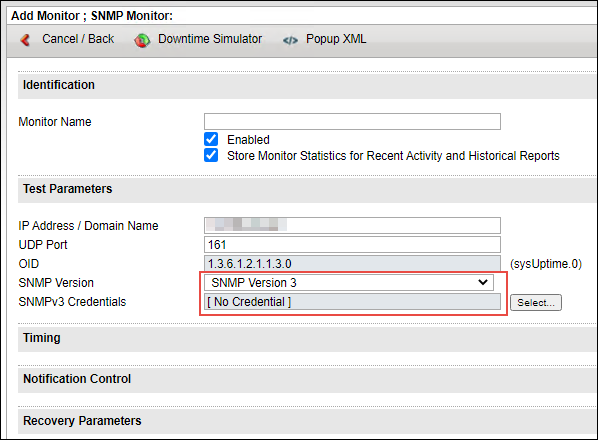Create the credentials using the Credentials Wizard
The Credentials Wizard allows you to create credentials while you configure a monitor, alert, or recovery action. You can apply restrictions on how the credentials can be used during this configuration process.
All new and existing credentials are stored in Credential Manager. After you create the credentials using the Credentials Wizard, use the Credentials Manager to edit and manage the credentials. ipMonitor uses AES 256-bit encryption internally to store all sensitive parameters and data.
- Configure a monitor, alert, or other feature that requires access to Windows file system objects or services through the network.
- During the configuration process, click Select when prompted to choose a credential.
- If the credential you want to use does not exist, click New Credential located in the pop-up window.
Your credential is saved in Credentials Manager. To edit or delete credentials, go to the Configuration tab and click Credentials Manager.
Required permissions
When you supply your credentials, ensure they include the required permissions to access the monitored resources. For example, if you intend to monitor an administrative share (such as C$), ensure that your credential is a member of the Windows Administrators group.
SNMPv3 authentication
SNMPv3 is a supported protocol. All monitors that support SNMPv3 have the option available in the setup screens when you add a new device, add a new SNMP monitor, or add a new credential.
Add a new device
The SNMPv3 option is available in the setup screen when you add a new device.

Add a new SNMP monitor
When you add a new SNMP monitor, the SNMPv3 option is available in the Add Monitor screen.

Add a new credential
When you add a new credential, the SNMPv3 option is available in the setup screen under Display Categories.

Local security policies and credentials
If the ipmonitorsrv service is running under a specific user account instead of the Local System account, ensure that the following Local Security Policies are enabled for this specific user account.
After you modify any of these settings, refresh the applied Local Security Policy settings.
| This credential type... | Requires these local policies |
|---|---|
| ADO |
Act as part of the operating system Bypass traverse checking Log on as a service |
| Directory |
Act as part of the operating system |
| Drive Space | Act as part of the operating system |
| Event Log | Act as part of the operating system |
| Exchange Server |
Act as part of the operating system Bypass traverse checking Log on as a service Replace a process level token |
| External Process | Bypass traverse checking |
| File Property |
Act as part of the operating system Bypass traverse checking Log on as a service |
| File Watching |
Act as part of the operating system Bypass traverse checking Log on as a service |
| FTP User Experience | None |
| HTTP-based | None |
| IMAP4 User Experience | None |
| MAPI User Experience |
Act as part of the operating system Bypass traverse checking Log on as a service Replace a process level token |
| Not Send |
Act as part of the operating system Bypass traverse checking Log on as a service |
| POP3 User Experience | None |
| RADIUS | None |
| Reboot Server |
Act as part of the operating system Bypass traverse checking Log on as a service |
| Restart Service |
Act as part of the operating system Bypass traverse checking |
| Service |
Act as part of the operating system Bypass traverse checking Log on as a service |
| Text Log |
Act as part of the operating system Bypass traverse checking Log on as a service |
